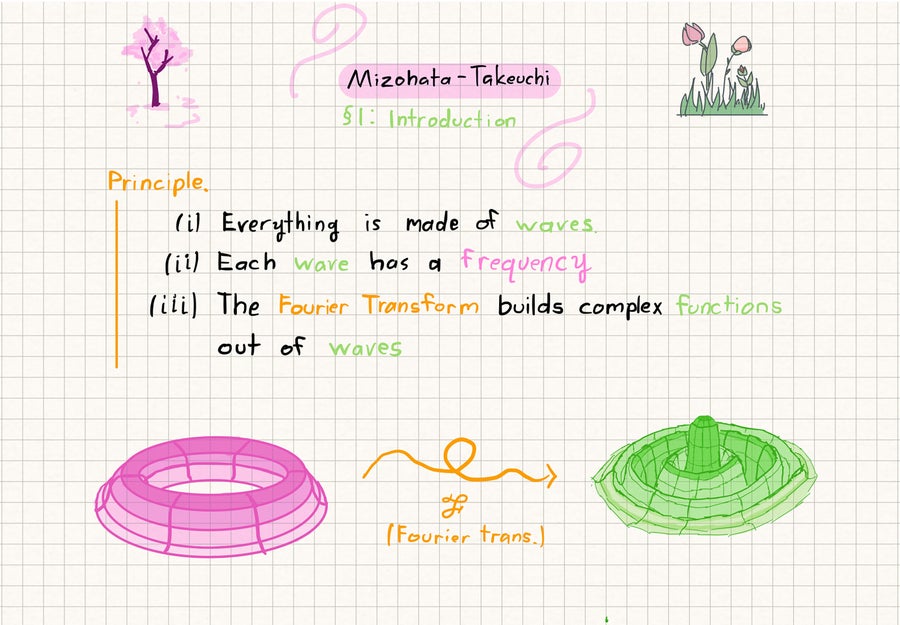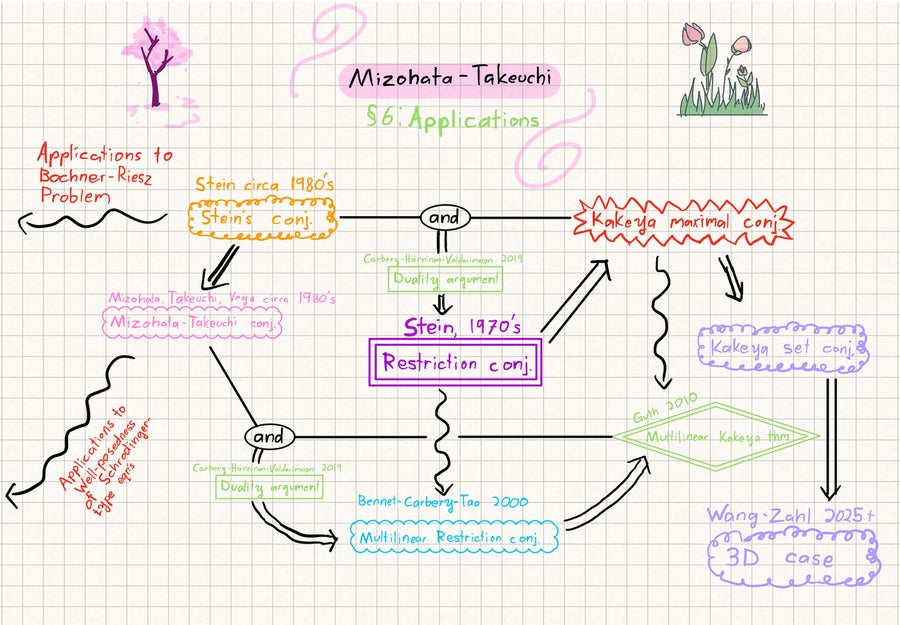When Hannah Cairo was 17 years old, she disproved the Mizohata-Takeuchi conjecture, a long-standing guess in the field of harmonic analysis about how waves behave on curved surfaces. The conjecture was posed in the 1980s, and mathematicians had been trying to prove it ever since. If the Mizohata-Takeuchi conjecture turned out to be true, it would illuminate many other significant questions in the field. But after hitting wall after wall trying to prove it, Cairo managed to come up with a counterexample: a circumstance where the waves don’t behave as predicted by the conjecture. Therefore, the conjecture can’t be true.
Cairo got hooked on the problem after being assigned a simpler version of the conjecture to prove as a homework assignment for a class she was taking at the University of California, Berkeley. “It took me a while to convince [course instructor] Ruixiang Zhang that my proposal was actually correct,” she says. Now, under Zhang’s advisement, she has a paper on the preprint server arXiv.org and was invited to present her results at the International Conference on Harmonic Analysis and Partial Differential Equations in El Escorial, Spain.
On supporting science journalism
If you’re enjoying this article, consider supporting our award-winning journalism by subscribing. By purchasing a subscription you are helping to ensure the future of impactful stories about the discoveries and ideas shaping our world today.
Cairo says she loves talking about her research and giving presentations with colorful and descriptive slides (see examples below). When asked what she studies, Cairo says, in short, “points, lines and waves.”
Born and raised in the Bahamas, Cairo moved to California at the age of 16, where she began to take classes at U.C. Berkeley. Now, at 18 years old, she is on to a Ph.D. program at the University of Maryland to continue her research in Fourier restriction theory. Cairo has faced many difficulties in her journey, but she has found comfort and belonging in the field of mathematics and in the work itself.
Scientific American spoke to Cairo about the way harmonic analysis is like dropping stones into a still pond, her transgender identity and the reasons she loves mathematics.
[An edited transcript of the interview follows.]
Beyond “points, lines, and waves,” how would you explain your field of study, harmonic analysis?
Imagine that you’re at a pond, and it’s a very still pond, and you drop a stone into it. You see these circular waves spreading out.
If you drop two stones in the pond, then you might notice this pattern called an interference pattern: instead of looking like circles, they overlap. You get high points, low points. And you get these interesting shapes [where they intersect]. What if you were to use a whole bunch of ripples—then what would you get? In harmonic analysis, you can actually prove that if you drop your stones in the right place in the pond, you can get any shape that you want.

Slide from Hannah Cairo’s presentation on the Mizohata-Takeuchi Conjecture
My specialty is known as Fourier restriction theory, which is the subdiscipline of harmonic analysis that I work in, where we ask what kind of objects can we build if we’re only allowed to use certain kinds of waves. What if we’re only allowed to drop the stones in certain parts of the pond? You won’t be able to get just any object. In fact, you’re only going to be able to get a relatively small family of objects. What the Mizohata-Takeuchi conjecture says is that the shape of the objects that we get are concentrated along lines.
What does it mean to be “concentrated along lines”?
One way to think of the shape of objects is to ask: What is curvature? There are a few different ways you can define it. One possible way is to take a thin, long rectangle and ask how much of your circle can lie in this thin rectangle. What you’ll find is that not very much of it can because it bends away, right? On the other hand, if you take something flat like the edge of a square, then you can get a whole side of that square just on one thin tube. So that means that the square is not as “curved” as a circle.
For the Mizohata-Takeuchi conjecture, we say, consider this object that we’re building out of these waves. And we want to say that not very much is going to lie on shapes that do not contain very many lines or thin rectangles.
So how did you manage to disprove this conjecture?
I looked at these shapes, and one thing that I realized is that the specific kind of waves that are used are concentrated along thick rectangles. This is actually something that is well known. So you end up looking at these waves that are concentrated on rectangles: You take these waves, and they intersect each other, and they make these certain shapes, but here [instead of circle waves] we use rectangle waves. So then we have all of these rectangle waves meeting each other. What I realized is that the shape of where they meet is not quite at the right angle to agree with the direction that these rectangles are pointing in. And so this led me to a rather complicated construction using fractals to arrange these rectangles.
The original fractal construction doesn’t actually show up in your paper though. What was your final counterexample?
What I found out is that if you arrange these waves by taking a high-dimensional hypercube and projecting it down into smaller-dimensional space and then taking only those waves that lie in your region, then this is how you can determine where to put them [to break the conjecture].
What first got you interested in math?
I’ve always been interested in math. I think that, for me, mathematics is an art. In my childhood, I was somewhat lonely. Math was sort of there as a friend almost. I think that art cannot necessarily be a friend in every way that a friend can be, but I think art is like a friend. And so, for as long as I can remember, I’ve always loved mathematics.
Tell me more about how math was a friend to you. I think a lot of people don’t think of math as very friendly.
There’s an analogy that I like to make, which is to another form of art: painting. And I think that if one were to take a class on paint, you could memorize the dates and times at which various forms of paint were developed—and maybe even which paints were used by which painters. And then you can figure out what processes you can use to determine what type of paint it is. I imagine this is useful in art history, but this is not art…. I shouldn’t say that. Maybe there is an art to learning about paint. I’m not going to claim that there isn’t because I don’t study paint. But I think that math is a little bit like that—in school, people learn about [the mathematical version of] paint; they’re not learning about painting.
Mathematics is comforting to me because it’s a way of exploring—to explore ideas and to think about them and to build more ideas out of other ideas. What’s comforting about that is that it’s independent of the world in some ways. If I’m having a sad day, a happy day, if I move to Maryland (I did just move to Maryland), mathematics is still there, and it is still the same thing. It’s also just something that can occupy my mind.
You’ve mentioned to me that you’re transgender. How has that affected your journey?
I think that it’s probably more relevant in my journey as a person than as a mathematician. Being trans has forced me to see things about the world that I maybe otherwise wouldn’t have seen. It’s made me see the world differently and made me see people differently and made me see myself differently.
Fortunately, in the math community, I think that most mathematicians are fine with trans people. I think that it used to be more significant [in my day to day] than it is now. These days it doesn’t really make much of a difference.
Why have you decided to go on the record now as being trans?
Trans visibility is important. People have ideas about who trans people are, and I think that it’s best to broaden that. Maybe I’m also hoping that people who think that trans people are “less” than cisgender people might find themselves questioning that.
The other thing is that it’s good for trans people to know that they’re not alone. I think that part of what helps trans people realize that they’re trans is to know that there are more options for who you can be as a trans person. That’s important to me.
Thank you so much for sharing that. Where is your favorite place to do math?
If I’m trying to be productive in writing something down, then I like to be at my desk, and I like to listen to Bach. If I am just trying to think about ideas, then my favorite place to do that is somewhere where I don’t have to pay attention to very much else. I could just be sitting down somewhere thinking about stuff, or I could be going for a walk outside.
I also like to talk to other people about math, which is another kind of doing math. I really like to give presentations about mathematics. I have these handwritten slides with all these colors and drawings. Luckily, in harmonic analysis, I can give a presentation like this, and then everybody is so happy, and they tell me my slides are cute.

The final slide from Cairo’s presentation on the Mizohata-Takeuchi Conjecture
What’s next for your research?
I’m working on a research project with my adviser on Mizohata-Takeuchi and adjacent stuff and about a sort of different thing: the local Mizohata-Takeuchi conjecture.
The process of learning more about this kind of mathematics is pretty exciting—not just for me learning more about what’s out there but for the math community as a whole to try to understand these kinds of things better. [That’s] something that I’m excited about.

